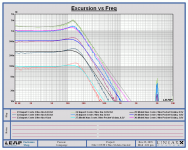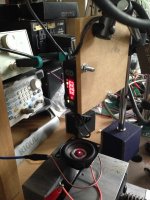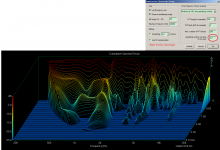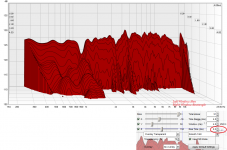Today I compared simulated excursion to measured excursion. The LTD driver model was created in EnclosureShop (ES) using VI-data obtained CLIO Pocket. Pocket was not in loop-back mode for impedance measurement. Its output was connected to an amplifier and input was used to measure voltage across driver and the current shunt, respectively. The current shunt was a 1 Ohm, 1% power resistor. Impedance was calculated using math function in Pocket's software. Different driver levels were used to obtain a set of impedance and voltage curves.
Impedance and voltage data were imported to ES to generate a LTD model for the driver under test (an inexpensive 2" full-range as shown in the picture). CLIO Pocket was also used to measure analog output of an laser displacement sensor for excursion data. The curves below show simulated and measured excursion data. They are closely matched. The model nicely predicates increased Q for higher driving levels.
Impedance and voltage data were imported to ES to generate a LTD model for the driver under test (an inexpensive 2" full-range as shown in the picture). CLIO Pocket was also used to measure analog output of an laser displacement sensor for excursion data. The curves below show simulated and measured excursion data. They are closely matched. The model nicely predicates increased Q for higher driving levels.
Attachments
If you have the CLIO pocket connected and software open but in 'stop mode' is it visible as a soundcard (audio in/out device) under Windows?
Why I'm wondering is that I did try this with Clio FW - one can use it as ARTA audio device while setting the input levels from CLIO sw. That way it makes a nice measurement front end for ARTA too. Just wondering if same is possible with Pocket.
(Most likely inetrnally it does have 2 input channels and other one is hard wired as a loopback all the time)
Why I'm wondering is that I did try this with Clio FW - one can use it as ARTA audio device while setting the input levels from CLIO sw. That way it makes a nice measurement front end for ARTA too. Just wondering if same is possible with Pocket.
(Most likely inetrnally it does have 2 input channels and other one is hard wired as a loopback all the time)
ARTA page has info about use of laser for displacement testing
http://www.artalabs.hr/AppNotes/AP7-EstimationOfLineardisplacement-IEC62458-EngRev01.pdf
http://www.artalabs.hr/AppNotes/AP7-EstimationOfLineardisplacement-IEC62458-EngRev01.pdf
CLIO version of use of laser
http://www.audiomatica.com/wp/wp-content/uploads/appnote_003.pdf
http://www.audiomatica.com/wp/wp-content/uploads/appnote_003.pdf
If you have the CLIO pocket connected and software open but in 'stop mode' is it visible as a soundcard (audio in/out device) under Windows?
No, it isn't. And it very much is single channel.
hi Panson hk, the laser unit to mesure what brand is ? and use special software?
thanks
Sorry. I did not see your question. It is cheaper indeed. I ordered it from Digikey.
I now use the laser to "estimate" low-frequency SPL without worrying reflections. I also want to use it in measuring TS parameter as described in the app note (http://www.audiomatica.com/wp/wp-content/uploads/appnote_003.pdf).
Last edited:
For distortion measurement, I use REW or ARTA; and considering to buy a LASER sensor for excursion vs distortion measurement in ARTA.
Hi panson
Comparing these measurement tools I realize that Arta is the most comprehensive one between accessibility and functionality.REW does well in its data curves's overlap but lacks of some functions.Clio pocket is less powerful than Arta but sufficient for common requirement. I think rectangle & Han window are enough for the truncating the data of no relevance like Arta does.
Both PN pink and swept sine are utilized in Arta,based on numerous tests,PN pink makes robust estimation in IR measurement than swept sine or MLS signal.MLS signal is inferior one that will cause much distortion due to maximum crest factor not suitable with soundcard. Usually I make a test using Arta and export .wav file into REW then make comparisons of data curves more intuitively.
All the Best
Hi panson
Comparing these measurement tools I realize that Arta is the most comprehensive one between accessibility and functionality.REW does well in its data curves's overlap but lacks of some functions.Clio pocket is less powerful than Arta but sufficient for common requirement. I think rectangle & Han window are enough for the truncating the data of no relevance like Arta does.
Both PN pink and swept sine are utilized in Arta,based on numerous tests,PN pink makes robust estimation in IR measurement than swept sine or MLS signal.MLS signal is inferior one that will cause much distortion due to maximum crest factor not suitable with soundcard. Usually I make a test using Arta and export .wav file into REW then make comparisons of data curves more intuitively.
All the Best
Hi there,
Thanks for your sharing.
My preferred excitation signal is log-chirp. Distortion data can be obtained simultaneously in one sweep. A nice soundcard, a measurement microphone plus software (like ARTA) costs similar to a CLIO Pocket system.
Cheers
I wrote an article in AX a couple months ago making exactly this comparison: ARTA plus soundcard is more powerful and versatile, but the CLIO Pocket is far simpler and faster to calibrate and use, and has become my "daily driver" for speaker measurement. It will do the vast majority of useful speaker measurements quickly and without fuss, the only really important missing feature is direct display of polar patterns. I break out ARTA when I need to do something more specialized like distortion vs level sweeps.
You might also check out Virtins Multi-Instrument, which is even more powerful and versatile than ARTA, though significantly more complicated to learn and use.
You might also check out Virtins Multi-Instrument, which is even more powerful and versatile than ARTA, though significantly more complicated to learn and use.
the only really important missing feature is direct display of polar patterns.
The latest CLIO Pocket software release supports polar plot.
Powerful software is attractive. Hardware specification is also vital as well. CLIO Pocket seems to be like a test equipment for engineering use.
Panson, how does CLIO pocket compare with REW?
With REW (free), you need a measuring mic and a notebook.
I guess that there are reasons why you opt for CLIO. Right?
Hi Arthur,
Yes, you are correct. A good quality mic and decent audio interface together cost not really cheap than the CLIO Pocket system. I purchased Audix TM-1 mic and PreSonus AudioBox audio interface before CLIO Pocket. There were two major reasons for adding CLIO Pocket. One was for making comparison using different measurement systems (REW, ARTA, CLIO). The other was CLIO was more or less a standard (low-cost one) for the industry. The later is actually more or less a non-technical posture for biz purpose. There are people not buying REW, ARTA, etc. performance as good as CLIO. I do agree careful calibration is needed for using sound card based approach.
REW offers much better data presentation. I occasionally export CLIO Pocket measured data to REW for generating graphs. CLIO Pocket meets 90% of my daily routines for speaker/driver test.
What system(s) are you using?
Hi Arthur,
There are people not buying REW, ARTA, etc. performance as good as CLIO.
Hi,Panson
Recently I realized that the CSD plot in REW is sightly different than that in Arta.
Here I upload the images and IR wave file that can import and view them carefully.
Unfortunately,I have not accessed the clio pocket so no chance for me to compare with them for accuracy.Furthermore,I didn't know about clio pocket whether .wav file can be imported.So if you got the time,you could make some comparisons between them on the CSD functionality.
Yes,the core functions in Arta and REW (also Clio)such as Tansfer Function,IR response,TS Parameter extraction,Distortion measurement are nearly the same
that makes no concern of the divergence,just each man has his merits in different aspect. Usually be in conjucated with several tools you will know grasp the peculiarity they own.
Panson,if you get the information then I am willing to hear from you,thanks!
Best
Attachments
The latest CLIO Pocket software release supports polar plot.
Powerful software is attractive. Hardware specification is also vital as well. CLIO Pocket seems to be like a test equipment for engineering use.
hello panson_hk, you have some information about mesurement distortion in clio pocket?
Spectrum measurement has good resolution, but frequency vs distortion is more transparent.
But without reservations, calibration for absolute SPL is in Clio best.
Hi Arthur,
What system(s) are you using?
I have a calibrated mic sitting next to me for a few months,
yet I have not started to use REW.
Due to my experience with ARTA (with e-MU 0404 and RME AIO),
I started to wonder whether it is better for me
to buy integrated products like CLIO pocket and QA401
instead of using a soundcard + freeware for measurement purposes.
It saves time. I want something convenient and functional.
Functionally, I guess CLIO, ARTA and REW are more or less the same.
- Home
- Design & Build
- Equipment & Tools
- CLIO Pocket



